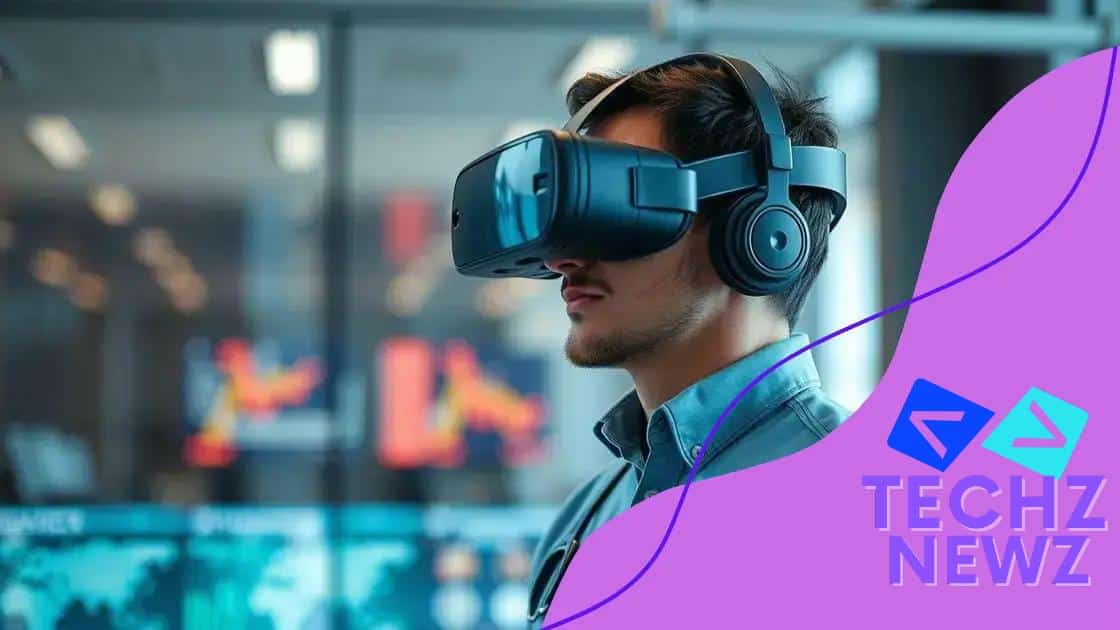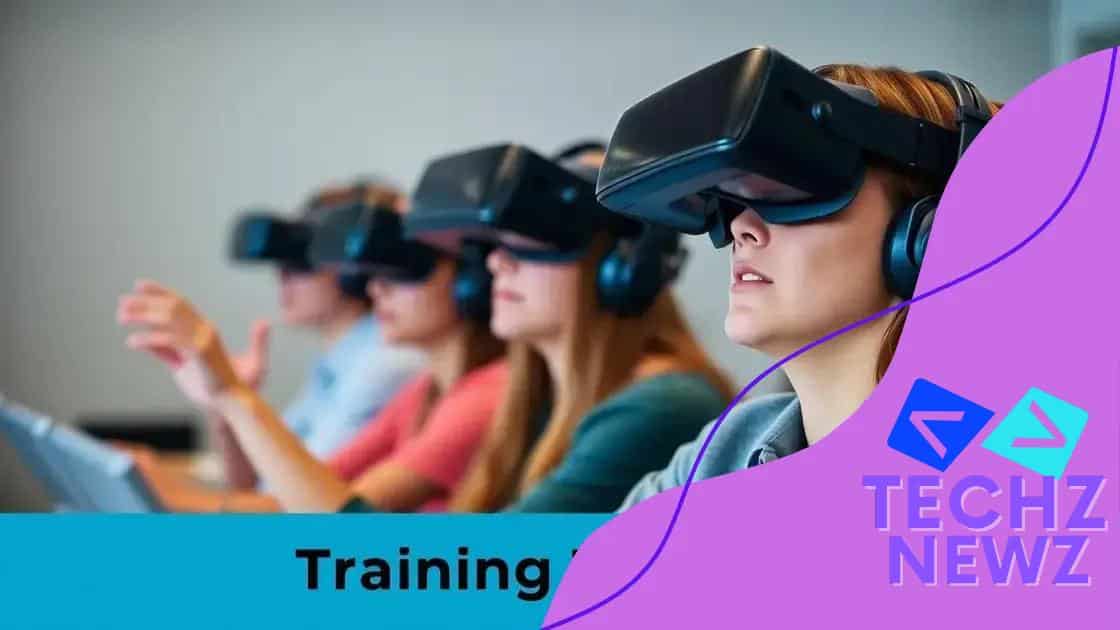Virtual reality for immersive job training: transforming learning

Virtual reality enhances immersive job training by providing realistic scenarios that boost learning retention, improve engagement, and facilitate collaboration among employees across various industries.
Virtual reality for immersive job training is changing the way we equip employees for their roles. Imagine stepping into a simulated environment where you can practice skills safely. Have you ever thought about how this technology could revolutionize your workplace?
Understanding virtual reality in training
Understanding virtual reality in training is essential in today’s fast-paced learning environments. By immersing learners in realistic scenarios, VR helps them grasp complex concepts more easily.
Imagine a medical student practicing surgery on a virtual patient. They can make mistakes without real-world consequences. This powerful training tool boosts confidence and skill.
How VR Works in Training
VR technology offers an engaging learning experience. Using headsets and controllers, participants interact with a virtual environment. They can explore, practice, and learn at their own pace.
Key Advantages of VR in Training
- Realistic simulations: Learners face real-world challenges.
- Safe learning: Mistakes made in VR don’t have real-world consequences.
- Increased engagement: Interactive environments keep learners motivated.
- Personalized experiences: VR can be tailored to different learning styles.
This approach not only enhances skills but also retention of knowledge. Studies show that learners using VR tend to remember information longer than in traditional settings.
Additionally, VR training can be applied across various industries, such as healthcare, aviation, and construction. Each field benefits from tailored simulations that mimic real-life situations.
Adopting VR in training programs can be a game-changer. Organizations that invest in this technology often see improved performance and faster learner progress. As immersive technology continues to evolve, the opportunities for enhanced training methods will expand further.
Benefits of immersive job training
The benefits of immersive job training are transforming how companies approach employee education. Immersive training provides a lifelike experience that traditional methods simply cannot match.
When employees engage in scenarios that reflect real-life challenges, they learn faster and retain information better. The result is a workplace filled with skilled and confident individuals.
Enhanced Learning Experience
One of the major advantages is the enhanced learning experience it offers. Immersive training allows employees to practice skills in a safe environment. They can make mistakes and learn from them without the fear of affecting real operations.
Improved Retention Rates
Another benefit is improved retention rates. Studies show that employees who participate in immersive training remember 75% of what they learn, compared to only 10% in traditional classroom settings. This significant improvement can lead to greater performance on the job.
Increased Engagement
- Higher motivation: Immersive training techniques keep employees engaged.
- Interactive scenarios: Realistic environments lead to active participation.
- Instant feedback: Learners receive immediate responses to their actions, aiding growth.
Additionally, immersive training stimulates critical thinking. Employees are challenged to make decisions in real-time, fostering a deeper understanding of their roles. This method encourages creativity and problem-solving skills.
Companies implementing these training methods often see a boost in employee satisfaction. When workers feel more capable and confident, it can positively impact workplace culture and productivity.
How VR enhances learning retention

How VR enhances learning retention is a crucial aspect of modern training methods. By using immersive experiences, virtual reality keeps learners engaged in a way that traditional methods may not.
When creating realistic scenarios, VR helps learners to visualize concepts. This mental imagery makes it easier to recall information later. Practicing skills in a virtual environment also allows for repetition, which is key for retention.
Active Participation and Engagement
Active participation is another reason VR improves retention. Unlike passive learning where students might daydream or zone out, VR requires learners to be fully involved. They must make decisions, interact with the environment, and solve problems in real time.
Emotional Connections
Understanding how emotional connections affect memory is also important. VR can create powerful emotional experiences. When learners feel a strong connection to the material, they are more likely to remember it. This emotional engagement can lead to lasting knowledge retention.
Repeating Scenarios for Mastery
- Practice makes perfect: Learners can repeat scenarios until mastery is achieved.
- Feedback loops: Immediate feedback helps identify mistakes and correct them quickly.
- Safe environment: Mistakes in VR don’t have real-world consequences, encouraging experimentation.
Furthermore, studies show that learners who experience content in multiple ways—visual, auditory, and kinesthetic—tend to retain information better. VR encompasses these elements, providing a richer learning experience. In turn, this boosts confidence and performance.
Companies adopting VR training often report higher retention rates than traditional methods. Employees feel more prepared and capable in their roles, leading to improved job performance.
Successful case studies with VR
Successful case studies with VR highlight the powerful impact of immersive training in various industries. Companies worldwide are embracing virtual reality to enhance employee skills and engagement.
In the healthcare sector, hospitals are using VR for training medical staff. For example, a prominent hospital implemented a VR program that simulates surgical procedures. As a result, surgeons-in-training gained valuable experience in a risk-free environment, leading to increased confidence and improved patient outcomes.
VR in Aviation Training
The aviation industry is another area where VR shines. Aviation schools are utilizing VR flight simulators to train pilots. These simulations replicate challenging flight conditions, helping pilots practice their responses to emergencies without the risks of actual flying.
Retail Training Success
Retail companies are also seeing benefits. One major brand created a VR training program for their sales associates. This program allows employees to interact with virtual customers and practice sales techniques.
- Increased sales skills: Employees learn effective communication.
- Improved product knowledge: Knowledge retention is higher through direct interaction.
- Heightened confidence: Staff feels better prepared for real-world interactions.
Companies that have integrated VR into their training programs are often reporting significant improvements in employee performance. These case studies show that immersive learning leads to better retention and application of skills in the workplace.
Furthermore, innovative organizations are experimenting with VR for soft-skills training as well. For example, a multinational corporation uses VR to train team collaboration and conflict resolution. Employees engage in virtual scenarios, enhancing their interpersonal skills.
As VR technology continues to advance, more industries will likely explore its potential. These successful case studies pave the way for future applications of immersive training.
Future trends in job training with VR
Future trends in job training with VR are shaping a new era in employee education. As technology evolves, so does the potential for immersive learning experiences. Organizations are increasingly recognizing the value of VR in enhancing skills and productivity.
One major trend is the rise of personalized training experiences. Companies will use data analytics to tailor VR training modules to individual needs. This customization will help address specific skill gaps and learning preferences, making education more effective.
Integration with AI Technologies
Another trend is the integration of virtual reality with artificial intelligence. Combining these technologies allows for adaptive learning environments that respond to a learner’s progress. As employees engage with VR, AI can provide real-time feedback and adjust the difficulty of tasks accordingly.
Collaborative Learning Environments
Furthermore, collaborative VR training is gaining traction. Virtual environments will enable learners to interact and work together, no matter where they are located. This social learning aspect promotes teamwork and communication skills, essential in today’s workforce.
- Global collaboration: Employees from different locations can train together.
- Shared experiences: Participants can learn from each other’s insights.
- Team-building: Collaborative tasks enhance group dynamics.
Additionally, as VR technology becomes more affordable, small and medium-sized enterprises (SMEs) will be able to adopt these immersive solutions. This democratization of technology will expand access to quality training for a broader range of employees.
Finally, the focus on soft skills training will grow. Future VR programs will emphasize emotional intelligence, adaptability, and leadership through simulated experiences. Such training will prepare employees not only for specific tasks but also for the complexities of modern work environments.
FAQ – Frequently Asked Questions about VR in Job Training
How does virtual reality enhance employee training?
Virtual reality creates immersive environments that allow employees to practice skills in realistic scenarios, leading to better retention and engagement.
Can VR training be personalized for individual learning needs?
Yes, future VR training systems will likely use data to customize experiences based on individual skill gaps and learning preferences.
What industries can benefit from VR training?
Industries such as healthcare, aviation, and retail are already using VR training to improve skills, safety, and customer service.
Is VR training suitable for small and medium-sized enterprises?
Absolutely! Advances in technology are making VR more affordable, allowing SMEs to implement effective training programs.





